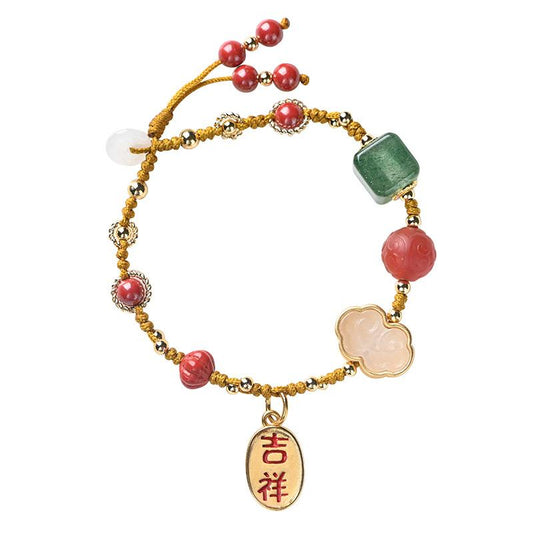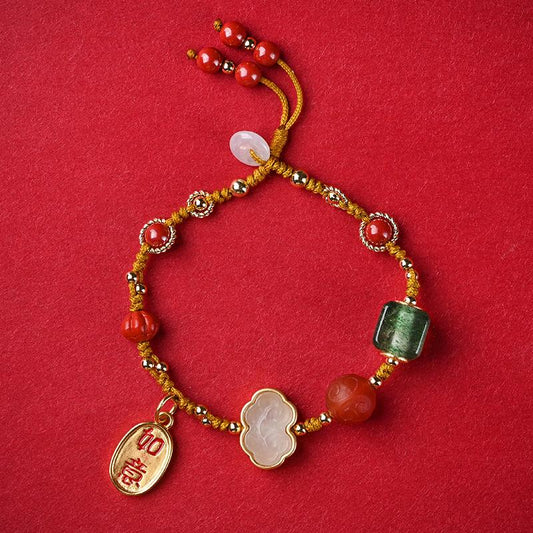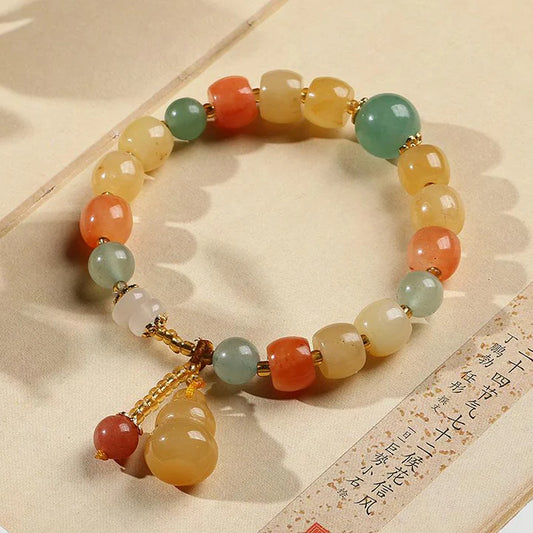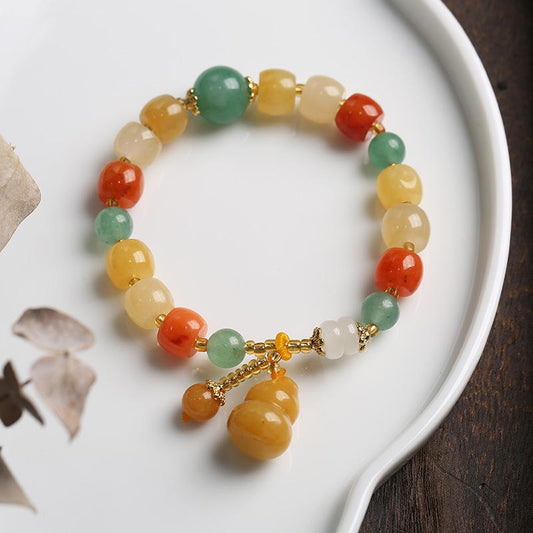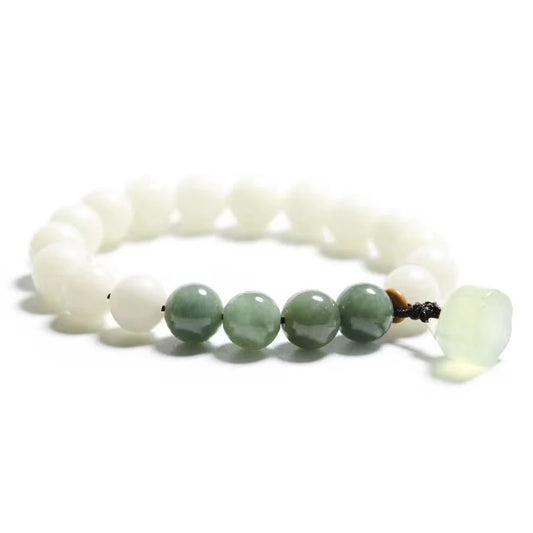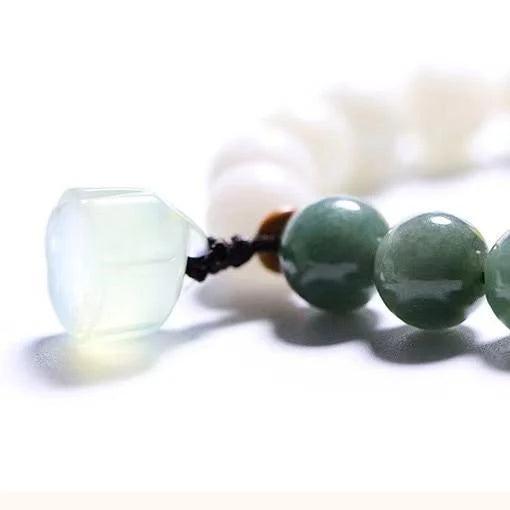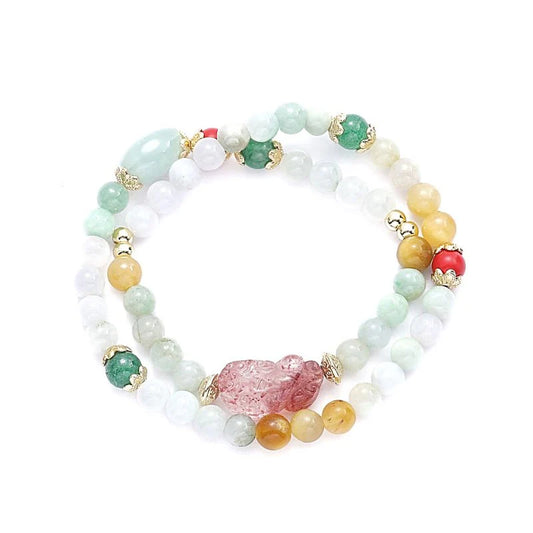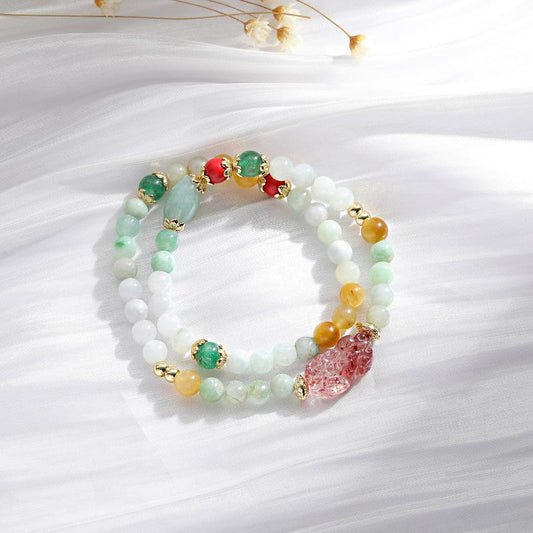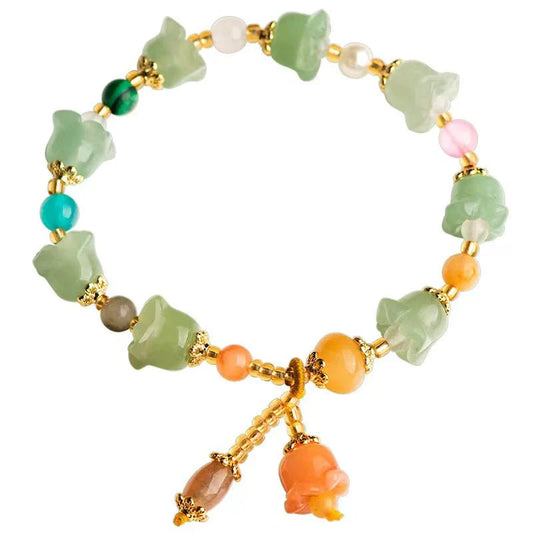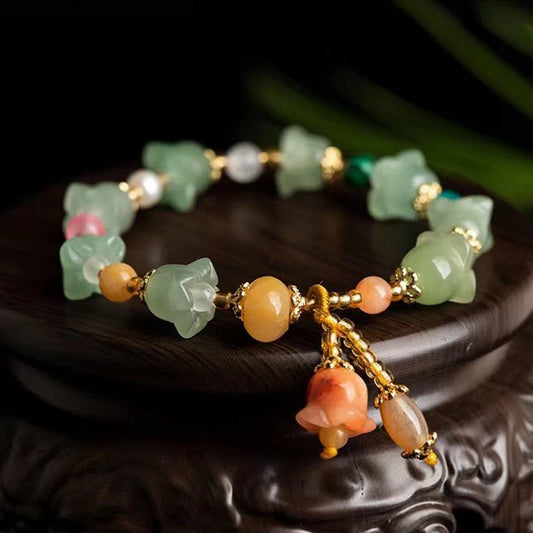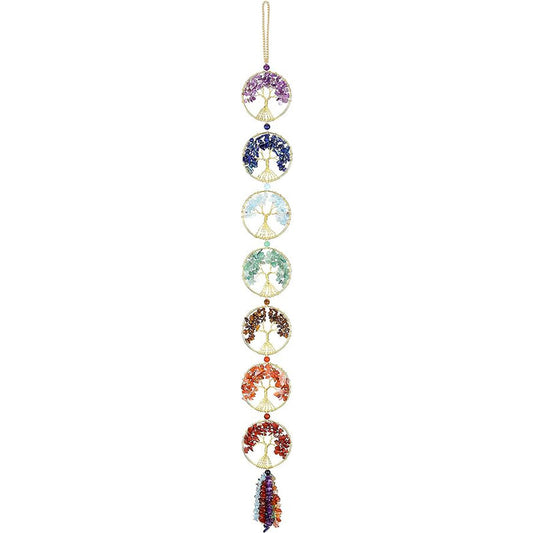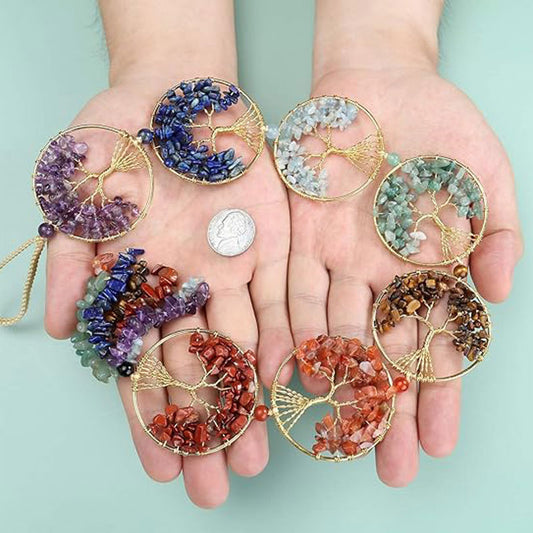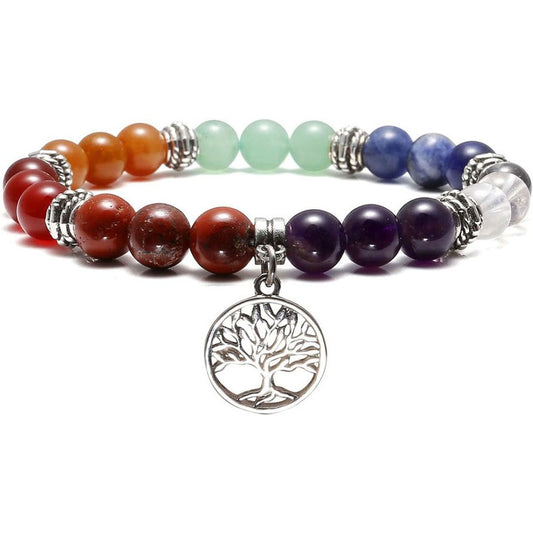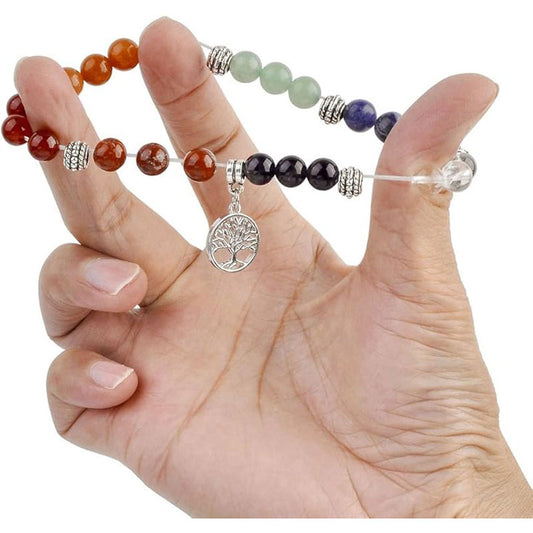What are Chakras
The word chakra originates from Sanskrit and translates to "wheel." In many Eastern traditions, there are seven main chakras that correspond to different areas of the body. These energy centers are formed when multiple channels intersect in the body. When there is an imbalance or blockage in the energy flow, it can lead to illness.
When the chakras are not aligned, it can have a negative impact on your mood, body, and overall health. To properly address this issue, begin at the Base chakra and gradually move up to the higher chakra levels. It is important to focus on healing the lower chakra levels first, as they are connected to our physical body and how we perceive the world. The three primary chakras below the Heart chakra have a more physical aspect, while the three primary chakras above the Heart chakra are more spiritual in nature.
View 7 Chakras Jewelry Collection

The Seven Chakras
Brow Chakra - Ajna, more commonly known as the Brow or Third Eye Chakra, is the sixth primary chakra situated in the center of the forehead, just above the eyebrows. The sanskrit translation for Ajna is "command," and it is represented by two petals that symbolize the dual nature of prana. This chakra is often viewed as the seat of intuition and intellect.
- Key points: intuition, wisdom, dreams, vision, clarity, spiritual guidance, psychic abilities
- Aromatherapy / Essential Oils: Frankincense, Basil
- Location: center of the brow
- Color: white or deep blue
- Gemstones: lapis lazuli (balancing)
Crown Chakra - Sahasrara, also known as the Crown Chakra, represents the balance of duality within us and is a place of pure consciousness. Located at the top of the head, this seventh primary chakra symbolizes the Thousand-petalled Lotus, as Sahasrara means "a thousand petals" in Sanskrit. This chakra is the origin of all other chakras.
- Key points: peace, pure consciousness, inner wisdom, spirituality, awareness
- Aromatherapy / Essential Oils: ylang-ylang, rosewood
- Location: top of head
- Color: violet
- Gemstones: clear quartz (balancing), amethyst (balancing)
Base Chakra - The first primary chakra, known as the Base Chakra or Muladhara, is located at the base of the spine (coccyx) and is often represented by four lotus petals. These petals symbolize control over passions, natural pleasure, and the ability to concentrate with blissfulness. Associated with the Earth element, the Base chakra is essential for grounding and establishing a strong foundation for life.
- Keypoints: health, grounding, survival, connection to Mother Earth, moving forward
- Aromatherapy / Essential Oils: cedarwood, patchouli, myrrh
- Location: base of spine / bottom of torso
- Color: red
- Gemstones: black tourmaline (calming/grounding), emerald (calming/grounding), carnelian (balance)
Throat Chakra - The Throat Chakra, also known as Vishuddha, is the fifth primary chakra that resides at the center of the throat. Its name comes from the Sanskrit word meaning "to purify" and is represented by 16 smoke-colored or turquoise petals. Acting as a connecting bridge between the Heart, Brow, and Crown chakras, it serves as a link between the physical and spiritual bodies. Communication is the main focus of the Throat chakra, and using positive words keeps it aligned. However, negative speech can cause imbalances and lead to physical symptoms related to the ear, nose, throat, and respiratory system.
- Key points: communication, self-expression, will
- Aromatherapy / Essential Oils: roman chamomile, lavender, thyme, rosemary, sage
- Location: center of throat
- Color: turquoise
- Gemstones: chrysocolla (balancing), turquoise (balancing), quartz (calming), yellow or blue topaz (activating)
Solar Plexus Chakra - The third primary chakra, known as the Solar Plexus Chakra or Manipura, is located between the navel and the bottom of the sternum. Its name, "place of gems," derives from sanskrit and reflects its ten petals. This chakra is responsible for regulating the flow of vital energy throughout the body and can bring about full knowledge and mastery of the body when properly controlled, according to the great Indian sage Patanjali. These ten petals symbolize various negative traits such as spiritual ignorance, jealousy, and sadness. It is essential to heal this chakra before working on aligning higher chakras.
- Keypoints: personal power, physical center, emotional control, anxiety, fear, introversion
- Aromatherapy / Essential Oils: clary sage, juniper, geranium
- Location: between naval and sternum
- Color: yellow
- Gemstones: yellow tourmaline (activating), topaz (activating), sapphire (calming), emerald (calming), citrine (balancing)
Heart Chakra - The Heart Chakra, also known as Anahata, is the fourth primary chakra located at the center of the chest on the sternum. Anahata, a Sanskrit term meaning "unstruck note," is represented by 12 petals. This chakra is not limited to physical love, but also encompasses appreciation for the beauty of life and creation, such as the scent of rain, the softness of a dandelion, and the pleasant sound of birds chirping. It serves as a gateway to higher consciousness.
- Keypoints: love, passion, trust, inner-child issues, safety, rejection
- Aromatherapy / Essential Oils: rose, melissa, neroli
- Location: center of chest
- Color: green and/or pink/red/white
- Gemstones: peridot (activating), rose quartz (balancing)
Sacral Chakra - The second primary chakra is called the Sacral Chakra or Svadisthana. Located just below the belly button, this chakra has six lotus petals and symbolizes "one's sweetest abode" or "one's own place". It is associated with affection, pitilessness, feelings of all-destructiveness, delusion, disdain, and suspicion. This chakra is responsible for assimilation in many aspects such as sexuality, food, ideas, and creativity. It is often referred to as the center of self-expression and joy.
- Keypoints: energy storage, creativity, addictions, relationships, sexuality
- Aromatherapy / Essential Oils: ylang-ylang, jasmine, sandalwood, rose, champaca
- Location: below belly button
- Color: orange
- Gemstones: emerald (calming), carnelian (activating), aquamarine (balancing), moonstone (balancing)

Chakras Healing
Improve your mental and physical health by working with chakras and energy, as believed by various belief systems such as Ayurveda, yoga, Buddhism, and Western "new age" spirituality across the globe.
Based on certain beliefs, the flow of life energy (prana) should be evenly distributed through the chakras. If a chakra is blocked or overloaded, it is considered unbalanced. By balancing your chakras, you can achieve a state of harmony and connection with the universe, as many believe.
Chakra-based therapies
The various techniques for unblocking, balancing, healing, or aligning chakras that are out of balance through chakra-based therapies may include:
- Color therapy and crystal healing. Color, crystals, and stones are often associated with the chakras, with some people using them to balance the energy of a specific chakra. They may gaze at the color or physically place a crystal on the corresponding area of the body.
- Yoga. Yoga is an ancient practice that aims to cultivate spiritual and physical well-being by channeling prana, or life energy, throughout the body to connect with the universe. Followers believe that through techniques such as focused breathing, poses, and meditation, yoga can aid in balancing chakras and reducing stress for improved overall health.
- Meditation and breathing exercises. Meditation can bring about a sense of mental calmness, connectedness to one's body, and attention to the present moment. In many cases, breathing techniques are incorporated into the practice. Certain forms of meditation revolve around the concept of chakras, with individuals visualizing a glowing or soothing energy within each corresponding area. This can aid in chakra alignment, stress reduction, and improved ability to handle life's obstacles calmly.
- Ayurveda. Ayurveda is an ancient Indian system of healthcare that utilizes a holistic approach. It incorporates various treatments such as herbs, plants, metals, yoga, meditation, physical and spiritual exercises to promote chakra balance and enhance overall well-being. This practice is still widely utilized today.
- Reiki. Reiki is an ancient Japanese practice of energy healing. Practitioners use their knowledge of energy flow to unblock channels and restore balance to the body. The chakras are often utilized as centers of energy during a Reiki session. Many people find Reiki to be a calming and beneficial experience for their overall well-being.














